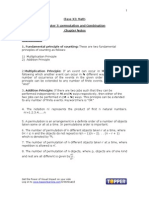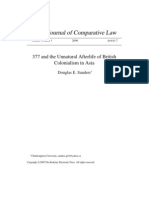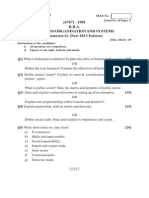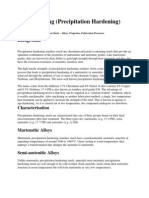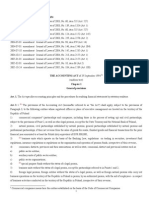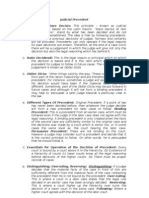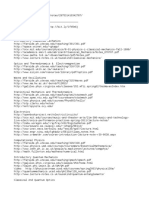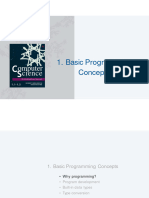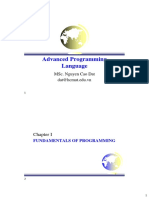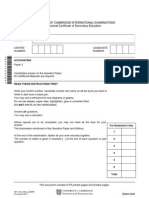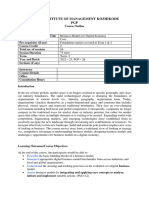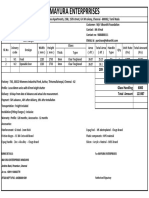RMIT University Programming Techniques COSC 1284
Lecturer Charles Thevathayan (charles.thevathayan@rmit.edu.au) Office location: 14.10.12 Head Tutor Rodney Cocker Contact him for any Admin matters (coursework, absence, etc)
Course Content Developed by: Charles Thevathayan, Caspar Ryan, Craig Hamilton and Peter Tilmanis
�COSC1284 Overview
1. 2. 3. 4. 5. 6. 7. 8. 9. 10. 11. 12. Introduction, programming languages, SE lifecycle Data Types, Decisions, Loops, Arrays Writing simple classes Inheritance Polymorphism Abstract classes and Interfaces Introduction to GUI Introduction to Event Driven Programming Exception handling and Files Generic Classes Revision
�Programming Techniques
One of the most important subject in CS as it is prerequisite for many others. Practical subject - requires at least 8 -10 hours of programming practice per week. Assessment 1. 40% Exam 2. 60% Coursework Programming Assignments 40% Mid-semester Test 20% Note: You need to pass both components ( 1 and 2).
�Resources
Prescribed: Programming Techniques Student Notes (2014), Department of Computer Science, RMIT Daniel Liang, Introduction to Java Programming, Ninth Edition, Prentice Hall (ISBN 978-0-13-293652-1 Recommended Reference: Absolute Java, by Walter Savitch Java Concepts, by Cay HorstMann There are numerous texts in Java On-line Materials WebLearn Quiz Copy of these Slides, detailed notes
�Assessment Schedule For detailed up to date guide refer to Course Guide
Week 5 First Assignment submit by Monday Week 8 Mid Semester Test to be taken during the week Week 12 Second assignment submission Week 14 Exam (10%) (20%). (30%) (40%)
�Recipe for Doing Well
Read the Subject Notes, on-line materials before going for Lectures. Review it afterwards. Attend all Lectures (2hr), Labs (1hr) & Tutes (1hr). Attempt the review questions before tutes (10%) Start Assignments Early - always takes longer than you think. They are all made available now. Complete all the lab exercises even if youre not required to submit them. Read the relevant section in text book before lecture Start Writing Programs in week 1 itself !!! Those who start early always do well.
�Introduction to the course Origin of Java Types of Computer Languages Compiling and Interpreting Components of a Java Program Classes and Objects Using the Java Docs to view the Class details Creating and Manipulating objects Packages in Java Algorithms Programming Style Programming Errors
Week 1
�Origins of Java
Originated as part of a Research Project Embedding networking capabilities and Cross platform portability
Originally called Green, then changed to Oak, finally Java
Design decisions drew from C++, Eiffel, SmallTalk Launched as an Internet extension for browser early 1995.
10
�Javas Design Philosophy
Simple Familiar to Developers Object Oriented Portable Multi-threaded Robust and Secure
Can you start tomorrow ?
What are the programming skills currently most sought after by employers? __________
11
�Machine language
Languages that a computer can directly understand. Differs from Machine to Machine. Example: 0010 0000 0011 0111 1100 0100 1100 0100
Operation code (load, add, save, )
Memory location
12
�Assembly language
One level higher than machine languages
Specified in terms of basic operations and symbolic names.
LOAD MOVE ADD
Hcost Tax Profit
13
�High- Level languages
Programs specified in an English-like syntax, and a compiler is used to translate it.
for (int year = 2000; year <2010; year++) System.out.println(Year is + year);
Each compiler produces a translation for a specific computer. Same source program can be run in another computer if it is compiled by the appropriate compiler.
14
�Divisions of High- Level Languages
Procedural - C, Pascal divided into procedures
Object-oriented - Java, C++, SmallTalk
based on interaction of objects
Logic languages - prolog
setting up goals
15
�Traditional Steps:
Compiling, Linking and Executing
Standard way of producing and creating an application 1.Create the program. Int add(int x, int y)
{ int z = ...
2. Traditional compilers translate source code into machine language directly. Int add(int x, int y) 01100 1001010
{ int z = ... 00010 1110101
3.Linkers link Standard code and library modules into executables
00100 1001010 11010 1110101 01100 1001010 00010 1110101
Executable file
00100 1001010 11010 1110101
16
�Whats different about Java ?
Java compilers translate source code into an intermediate language called (platform independent) bytecode.
Public class HelloWorld { String s = Hello World;
Compiler (javac)
bytecode
The Java interpreter reads the bytecodes (loads the necessary library bytecodes) and executes it on a specific machine.
bytecodes
Interpreter (java)
Hello World
Unlike machine code Java bytecode is not tied to any particular machine making it architecture neutral.
17
�Editing, Compiling & Interpreting
Step1 - Create the code using an editor H:\>edit HelloWorld.java Step2 - Compile the code using javac H:\>javac HelloWorld.java Step3 - Interpret and execute the program H:\>java HelloWorld
Java source code
Java compiler
Java bytecode
Java interpreter
Bytecode compiler
Machine code
Give one benefit and one drawback of Java over other high level languages such as C or Pascal. _____________________________________________
18
�Two type of Java Programs: Applets
Designed to be remotely downloaded as part of an HTML page and executed in the client machine. They are executed in a browser or appletviewer.
19
�Two type of Java Programs: Stand Alone Applications
Stand-alone applications are similar to other applications written in high level language. Though stand-alone applications can incorporate Graphical user interface and events (mouse-moved, buttonpressed) we will concentrate on console based applications in this module.
Enter Name Robert Homewood Enter Course CS Hello Robert Homewood Welcome to CS Course
Console application
20
�First Java Program
// The first Java program // The famous Hello World! public class HelloWorld { static int year; public static void main(String[] args){ year = 2007; System.out.println(new String("Hello world ) + year); } }
H:\>javac HelloWorld.java H:\> java HelloWorld H:\>Hello World 2007
21
�Java is about creating & using classes !!!
All Java programs must have at least one of this
public class HelloWorld { static int year; public static void main(String[] args) { .. } }
Classes contain variables and methods
Classes, methods and related statements are enclosed between { ... }
22
�Making code more Readable
Use Comments, they make your programs readable They can appear anywhere in a program They are ignored by compiler Type 1 // up to the end of the line is a comment Type 2 /* all character enclosed between these are comments - hence ignored */ Dont overdo it x = y; // assigning y to x (obvious!)
/* My first Java program prints the famous Hello World! The tradition says all great programmers must do this*/ public class HelloWorld { static int year; // current year public static void main(String[] args){ .. } }
23
�Quiz Time:What is the output ?
// The first Java program // The famous Hello World! public class HelloWorld { static int year; public static void main(String[] args){ // year = 2001; System.out.println("Hello world + year); } }
(a) (b) (c)
Hello World Hello World 0 Hello World 2001
24
�Where does the execution begin ?
Recall how we ran the program HelloWorld with: H:\> java HelloWorld Q. Where does the execution begin ? A. With the main() method of HelloWorld
public class HelloWorld { int year; public static void main(String[] args) { .. } }
25
�What will be the output when we compile and interpret the code below ?
public class HelloThere { public static void anotherMethod( ) { System.out.print("There "); } public static void main(String[] args) { System.out.print("Hello "); } }
(A) (B) (C) (D) Hello There Hello There There Hello
26
�What will be the output now ? (note the additional line in main() )
public class HelloThere { public static void anotherMethod( ) { System.out.print("There "); } public static void main(String[] args) { System.out.print("Hello "); anotherMethod(); } }
(A) (B) (C) (D) Hello There Hello There There Hello
Why do we use methods? _____________________
27
�Terminating statements
Each statement must ends with a semicolon ';
System.out.println("Hello");
System.out.println("World");
Hello World
The effect is still the same with two statements in the same line as in: (but considered poor style !)
System.out.println(); System.out.println();
28
�Class and Objects
A class can be compared to a blueprint created by an architect when designing a house. It defines the important characteristics of the house such as walls, windows, electrical outlets etc. Once we have the blueprint several houses can be built using that . They may have different addresses, furniture, colors etc.
12 Sydney rd
67 Yale ct
82 Betula av
Similarly a class is a blueprint for objects.
String
String Hello
String World
String Universe
29
�Using the Java Docs
All the classes available and their method details can be viewed easily using the Java Docs. Get lab-assistants help this week
classes
30
�Creating new Objects with new
In Java we are provided with a number of pre-created classes such as String, Rectangle ... New String and Rectangle objects can be created with these class by using the operator new (see below). The statement below creates a new Rectangle object and passes it to the println() method which is a method of the pre-defined PrintStream class.
System.out.println(new Rectangle(10,5,20,30));
This method causes the details of the Rectangle object to be printed in the terminal.
java.awt.Rectangle[x=10,y=5,width=20,height=30]
31
�Getting a handle to an Object
Suppose we want to manipulate the Rectangle object created, before printing its details (using one of its own methods). For example, we may want to apply the translate(int x, int y) method of Rectangle class on that object. Before we can call one if its own methods, somehow we need to get a handle to the object ! Next program declares a Rectangle reference and sets it to point (refer) to the newly created Rectangle object with:
Rectangle rect1 = new Rectangle(10,5,20,30);
Rectangle reference rect1
Rectangle Object
Subsequently its own methods are called through that reference.
Rectangle
x=10, y=5, width=20, height=30
32
�Manipulating the Rectangle Object
import java.awt.Rectangle; public class HelloRectangle { public static void main(String[] args){ Rectangle rect1 = new Rectangle(10,5,20,30) System.out.println(rect1); rect1.translate(20,30);//shifting the location System.out.println(rect1); } }
rect1
Rectangle Object
(initial state)
x=10, y=5, width=20, height=30
Rectangle
rect1
Rectangle Object (final state) x=30, y=35,
Output from the program
java.awt.Rectangle[x=10,y=5,width=20,height=30] java.awt.Rectangle[x=30,y=35,width=20,height=30]
Rectangle
width=20,
height=30
33
�Creating and manipulating Objects Summary
To access an object of class X say, we must declare a reference to that class X. Then this reference must be set to refer to that object with a statement of the form X refX = new X(); Now we can easily manipulate the X object using one of its own methods say meth1() as in refX.meth1(...);
X reference refX
X meth1(...) meth2() X Object
34
�Time to pause.
1. Which of the following is true? I. A class can have many objects (or instances) II. An object (or instance) can have many classes 2. How do we create an object (or instance) of a specific class? ______________________________________
35
�Another Quiz
What will be the output of the program below?
public class RefTest { public static void main(String args[]) { String s; // a String reference s = new String("Apple"); s = new String("Orange"); s = new String("Banana"); System.out.println("s is now referring to " + s); } }
____________________________________________________ Conclusion: At any one time, a reference can refer to ________ (single/multiple) object(s).
36
�Spot the Errors and state the Reasons
Rectangle r1 = new Rectangle(10,10,5,10); String s = new String(" Good day "); String r2 = new Rectangle(10,10,5,10); String r3 = new String(" Good day "); // // // // A B C D
Ans:
Rectangle r1 = new Rectangle(10,10,5,10); r1.translate(20,30); String s1 = new String(" Monday "); s1.translate(20,30); // // // // A B C D
Ans:
37
�String class - a special one
program below declares a String reference aMessage and sets it to refer to a newly created String object. Subsequently we output that String object using the String reference aMessage .
public class HelloWorld { public static void main(String[] args) { String aMessage = new String("Hello"); System.out.println(aMessage); } }
String Hello
object
aMessage
reference
As String objects are commonly used, they need not be created explicitly using the operator new. Hence the 3rd line can be replaced with: String aMessage = Hello";
38
�Java provides pre-created objects for Input/Output
System.out refers to an object of PrintStream class. As console input/output is common in Java, they have pre-created objects of type PrintStream (for output) and InputStream (for input). To make them easily accessible the System classes contains references to these objects as shown here. System.in InputStream PrintStream
System.out
Pre-created PrintStream Object (associated with keyboard) (associated with terminal)
39
Pre-created InputStream Object
�So what do I need to know about these precreated objects ?
You are free to write to the terminal by writing directly to the object System.out. You are free to use any of the methods of PrintStream class Keyboard input requires little more processing - we will have to wait until next week
40
�Using packages
In the last program we specified that we are using the Rectangle class of the java.awt package. import java.awt.Rectangle; All classes in standard library are placed in packages: java.awt, java.io, To import all classes use: import java.awt.*; Package java.lang is automatically imported - contains String,System, ... You can place your own classes in packages too - to avoid name clash.
Frame java.awt package Rectangle
Menu
myown.graphics package
Ellipse Rectangle
Parabola
Square
41
�Stages in Software Development
Specify
What must it accomplish ?
Analyze
Refine the requirements.
Design
How to do it ?
Use Algorithms, classes, Object Interactions
Write a program to find the roots (real) of a quadratic equation of the form: ax2 + bx + c = 0.
Understand specification
Implement
Code the programs
Test
Run program with different inputs and verify results
Document
Make it maintainable
Document the program
Analyse
Design
Code program Debug Test program
42
�An Algorithm to find the roots of a quadratic equation
Algorithm is a step by step procedure in some form of English 1. Prompt and read the coefficients a, b and c 2. Compute the roots if any and display
2.1 Compute discriminant disc=b2-4ac 2.2 If (disc>=0) compute r1 = -b + disc compute r1 = -b
2a
disc
Refine Step 2
display r1 and r2 2.3 Otherwise display no Real Roots
2a
43
�Some Reserved Words
Examples: class, static, public, void. They have been reserved by the designers and they can't be used with any other meaning.
For a complete list see the prescribed book.
44
�Programming style
Java does not impose a particular style but there are rules most Java programmers follow. One statement per line
System.out.println(Welcome to RMIT); System.out.println(Welcome to CS);
Indentaion (3 spaces) show dependency
public static void main(String[] args) { String aMessage = new String("Hello");
Comments help clarify the code Use blank lines to separate logical sections Use meaningful identifiers but not verbose
45
�Finding the roots of a quadratic Equation
/* Written by CT 23/02/2006 This program finds the roots of a quadratic equation */ import java.util.*; public class FindRoots { public static void main (String[] args) { double a,b,c; // coefficients of the equation double r1=0.0, r2 = 0.0; // real roots of the equation double disc; // discriminant Scanner console = new Scanner(System.in); // Getting user input for coefficients System.out.println ("Enter value for a"); a = console.nextDouble(); System.out.println ("Enter value for b"); b = console.nextDouble(); System.out.println ("Enter value for c"); c = console.nextDouble();
46
�Finding the roots of a quadratic Equation
// Computing results disc = b*b - 4*a*c; // no real roots exist if discriminant is negative if (disc > 0.0) { r1 = ( -b + Math.sqrt(disc)) / (2*a); r2 = ( -b - Math.sqrt(disc)) / (2*a); } // Displaying results if (disc >= 0) System.out.println("Roots are " + r1+ " and " +r2); else System.out.println("No real roots exist"); } }
47
�Sample User Interface for FindRoots program
Enter the value for a 1.0 Enter the value for b 3.0 Enter the value for c 2.0 The roots are -1.0 and 2.0 Enter the value for a 4.0 Enter the value for b 2.0 Enter the value for c 6.0 No real roots exist
What if I input an alphabet such as s as input to a ?
48
�Choosing Identifiers
Identifiers should be meaningful, but not verbose. Any combination of letters, digits, dollar signs '$' underscore characters '_', not beginning with a digit, is legal. Legal: Total, lastWord, TaxCalculation Illegal: 3rdAmmendment, you too, you#too Avoid: s1, theFirstOfTheStudentsInTheClass Acceptable : student1, stud_1, firstStudent
49
�Programming Errors: Compilation Errors
detected at compile time (javac hello.java) caused by undeclared variables, missing semicolons, incompatible types
disc = b*b - 4*a*c
// missing semicolon
double r1 =0.0, r2=0.0; . root1=(-b + Math.sqrt(disc))/(2*a);
// undeclared variable root1
int disc; .. disc = b*b-4*a*c;
// double value cannot be assigned to int
50
�Programming Errors: Execution Errors
appear when the program runs (java Hello). Examples are, a division by zero, an input of the wrong type, finding the square root of a negative number etc. Typically execution stops when an exception such as these happens. For example if in the FindRoots program we input an alphabet (such as s) execution will stop with an error.
Non-numeric value
Enter value for coefficient a s Exception in thread main java.NumberFormatException: s
51
�Programming Errors: Logic Errors
program compiles and runs, but the results are not what they should be. For example in the FindRoots program if we write
r1 = -b + Math.sqrt(disc) / (2*a);
instead of
r1 = (-b + Math.sqrt(disc)) / (2*a);
the wrong roots will be printed.
52
�Exercise
A. The program below written to find average of two weights has 3 syntax (compilation) errors and 1 logical error. Identify and correct them.
public class Add { public static void main(String args[]) { double weight1 = 85.5 double weight2 = 92.3
double averWeight = weight1 + weight2 / 2; System.out.println("Average is " + aver);
} }
B. What changes are needed to find average of 3 weights 85.5,92.3 and 78.4 ?____________________________
C. What changes are needed to find average of other weights without having to change the program ? _____________
53
�54
�55
�56
















